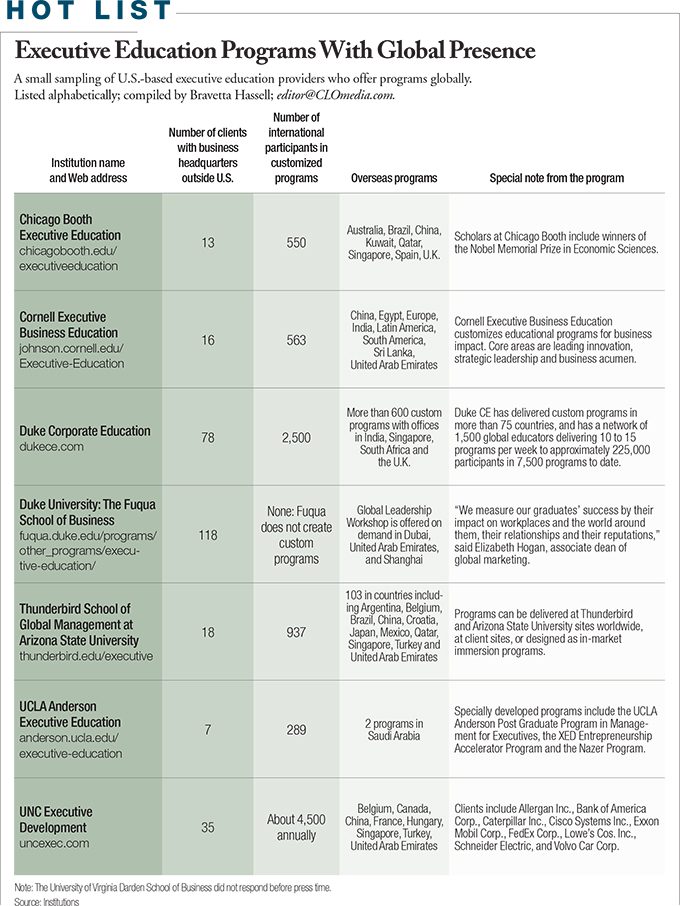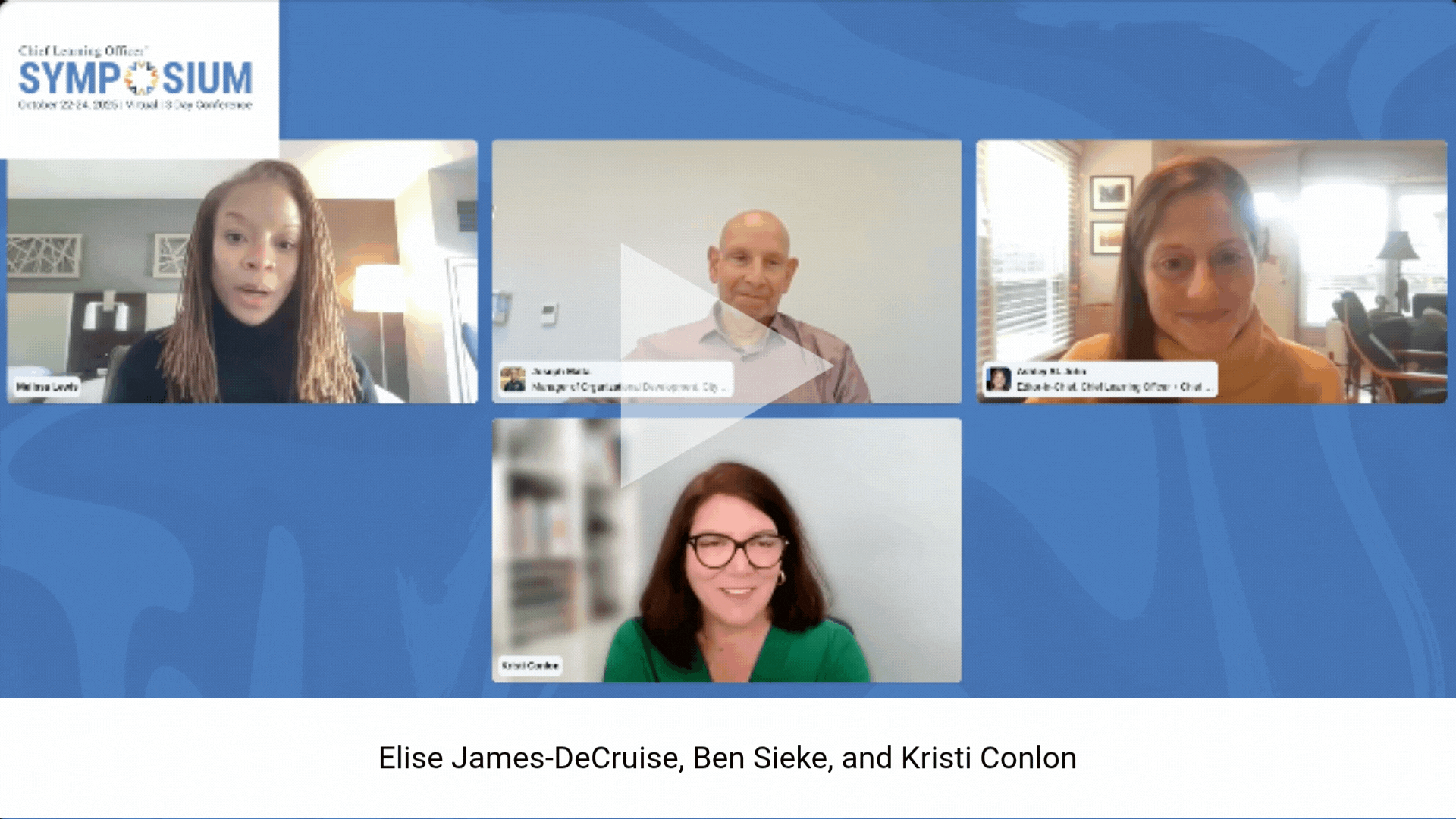Cigna Corp. Chief Learning Officer Karen Kocher couldn’t be happier with the executive education programs the company invested in.
Program participants continue to speak about how valuable the learning experience was. One man often reflects on the inspiration he was able to draw to solve real-time business challenges. “You know something is valuable when you not only learn from it or within it, but you can actually make real-world situations better,” Kocher said.
Over the past five years, the University of Virginia Darden School of Business helped the global health insurance service company develop general leadership skills, while Dartmouth College Tuck School of Business focused specifically on developing global acumen to create globally savvy and capable leaders.
Dartmouth was especially appealing for global leadership because of its consortium approach. Cigna’s people could learn from experts as well as exchange ideas and insights with a blend of people from four other companies, Kocher explained. “It was creative; it was effective.”
Critics of executive education often speak about the gap between organizations’ talent management needs and the university lecture hall. It’s that focus on real world problems that has made Cigna’s experience successful. But not all are satisfied with their executive education offerings.

Customization Is Key
Savvy executives often point out the obvious: By its very methodical and measured nature, academia is not agile or adaptable enough to meet C-suite executives sophisticated development needs.
Devin Bigoness thinks it is. As executive director for executive education at the Johnson School of Management at Cornell University, and project director for Duke Corporate Education before that, his work depends on a belief that executive education can bring value to the corporate landscape.
Consider the multidisciplinary nature of the university experience. “More and more businesses are having to develop into the business of everything,” Bigoness said. “Everyone from trade associations to Fortune 500 companies is trying to develop leadership capabilities and business acumen in their people — big challenges the head of talent, HR and learning face, but also the business line faces. Universities have a distinct capability set they can bring to the table.”
Johnson & Johnson is using the school’s offerings to teach its leaders how to better think about applied innovation for the company’s translational medicine compound teams. Tapping into the university’s business, applied science and engineering research and expertise is creating an inherently dynamic partnership, Bigoness said.
The Johnson School of Management’s focus is customized executive education, helping organizational leaders execute their given strategy by building and developing extant and new talent capabilities. The question, how can academia help businesses, is constant for Bigoness and his team.
“How do we leverage all that we can bring in the context of business education, whether that be in engineering, agriculture, law, medicine or business, the broader disciplinary research and the work that’s been done?”
He said once staff has an understanding of an organization’s strategy and goals, and its current capabilities, members can collaborate with the learning leader to design an education solution using Cornell’s various resources. The outcome is a tailored fit, so no two solutions engineered by the school are alike. Bigoness said this consultative and highly customized approach is how executive education programs will find success.
Historically, when business schools engage with organizations, the challenges organizations face fit neatly into the buckets a major business school works with such as finance, marketing and strategy. But myriad developments in the past 10, particularly the past five, years have created a more diverse, multilayered and ever-unfolding set of problems that surpass the value in a mass manufactured, prefabricated solution.
Business problems are deeper, more global, more complex, and Bigoness said executive education providers need to be able to serve clients in a much broader way. Provider range and flexibility is one among a handful of things Kocher said were especially essential to find an executive education offering worth the investment. Other things include: customer centricity, agility and creativity.
These essential offerings are why leadership expert Roger Martin cautions learning leaders to run if a prospective executive education provider doesn’t have a customer-focused attitude. The former dean of the Rotman School of Management at the University of Toronto said executive education is not about getting tools a company thinks might fix a problem.
“It’s let’s go get somebody who will be able to say I will work on that problem with you, and in the process of it, transfer from me to you some skills,” he said.
Speed, Responsiveness Core
For a program to be responsive to an organization’s learning and development needs, it needs the resources to effectively meet them. And as varied as the companies and organizations — multinational companies to trade and industry associations as well asFortune 500 companies — seeking solutions are, so must the solutions and expertise that drives them.
Cornell’s Steven Miranda said before any plan can be executed, an attentive executive education program should engage in some corporate client fact-finding. His program’s preliminary work begins with some quantitative homework — discovering what’s happening with the company, whether its business performance is on the uptick or downturn and what he calls “aggressive listening” — all to surmise what’s shaping the current environment from which the organization is strategizing and developing.
His biggest criticism of executive education programs is they rely too heavily on “canned content” and not enough on customized delivery relevant for the culture and organization in question.
Open Enrollment vs. Custom Programs
Open enrollment executive education — existing academic programs open to all — isn’t for everybody.
Determining an organization’s leadership development needs and who exactly the resources are best suited for can make all the difference, said Steven Miranda, managing director for Cornell University’s Center
for Advanced Human Resource Studies.For today’s executives, one can be certain of at least two things: they’re short on time, and what time they do have is precious.
C-suite leaders will reap little benefit from a classroom experience that doesn’t tap into and integrate the personal experiences and insights they bring to the table. Content that isn’t customized to their organization-specific leadership and business needs is useless content.
Organizations also must consider the midlevel and more junior management, whose development is just as critical but for whom a highly customized, one-on-one-minded program is just not economically feasible, Miranda said. To meet the learning needs for these cohorts, organizations may want to offer a more broadly applicable open enrollment learning experience.
That doesn’t mean the learning is dated. It’s imperative for both the executive education provider and the client organization that offerings are not out of date. Miranda said he is a big believer in executive education programs not only offering contemporary education in topics of interest to corporate customers but also delivering on the classic business school training that organizations ask for year after year.
Organizations considering open enrollment for staff development should make sure material is current, he said, “ripped from the headlines so that people can look at it and say, ‘Oh, OK, this isn’t, say 100 percent applicable to the pharmaceutical industry, but it is definitely applicable to the world we live in today.’ ”
A strong customized program can position executives to meet current challenges they are experiencing — with support. Open enrollment programming for midlevel, junior-level as well as senior leadership can help different cohorts learn the skills they need using insights from multiple industries and offer unique learning and networking opportunities.
But Miranda said the bottom line is: “Absolutely customize at the top of the house, a little bit less so in the middle to lower levels simply because of the economics of the volume that you have to deal with.”
—Bravetta Hassell
“One of the mistakes a lot of executive education organizations make is they enter into the first conversation in sell-mode,” Miranda said. “The first couple of conversations we’ll have with you will be lots of listening and lots of asking questions, so we’ve got a better understanding of what your challenges really are.”
In the old days, Kocher said organizations went almost exclusively the academic route for outsourced leadership help. Then the tide shifted, and learning leaders moved away from academia and toward for-profit partners. Why? The universities weren’t agile enough.
“When you’re working with an academic institution, things tend to work at a different pace so it’s difficult to find an organization not only customer-centered but also agile,” she said. “Typically when we finally decide what we need and we want to get it, it’s not unlike most companies — we want it to start yesterday. That’s difficult for a lot of organizations, let alone academic institutions.”
It’s a persistent reality Miranda acknowledges when considering how Cornell, or any executive education provider, can stay competitive and valuable. Institutions can have all the great academic material they want, but the executives need personal, real-time experiences they can use inside and outside of the classroom.
“Unless you’re creating an experience that integrates their learning into the actual program, that takes advantage of what they know, you’re going to be unsuccessful,” he said.
That’s why preliminary homework is so important, and why Miranda and his colleagues make it a point to stay connected to corporate HR, talent management and learning and development leaders, as well as read industry publications to keep up to speed on what companies are facing, thinking about and might come knocking at the door for.
For example, take change management. One executive education strategy might be effective for a Fortune100 tech company, but that same strategy likely won’t produce the same results for the United Nations, Miranda said.
While both are highly complicated, globally diverse organizations with very smart people at the helm, each one’s culture is different.
“The core content of what you’re delivering will be pretty much the same, but the way you link in with the executives in those organizations, that’s what makes a program unique and competitively advantageous to take,” he said.
Further, organizations stand to gain more from a partnership when executive education programs use their insights and resources to facilitate learning and experiences that have current and future value.
Creativity wasn’t the primary decision-maker in Kocher’s provider selection to help Cigna meet its global leadership development needs. The fact that Dartmouth had developed a consortium approach, an on-the-ground global learning experience and a blend of academic and corporate — even journalistic — resources to support its learning, was a tie breaker.
“People have come back from in-country experiences with a better appreciation of what it really takes to be an effective global leader,” she said. Even better, participants create relationships across companies, talking with new peers about business challenges and new opportunities.
MBA Down, Exec Ed Up?
While an executive experience like Cigna’s sounds idyllic, it’s not necessarily the rule, said Rotman School of Management’s Martin, in “Are U.S. Business Schools Headed for A GM-Like Fall?” an August 2015 Poets & Quantsarticle. He likened the future of contemporary MBA programs to a fate similar to General Motors in the 1970s. But he won’t lump executive education in that barrel because the stakes are higher — teaching executives makes a difference.
“Generally speaking, the people who do executive education are professors who like teaching and put a high preference on teaching,” Martin said. “And because executive education is a competitively harsher environment, if you teach badly to executives, you don’t get asked back.”
Still, these programs’ inability to meet today’s needs with cutting-edge resources instead of trying to apply yesterday’s classic theories to 21st century problems could be their downfall. Martin said it’s often easier to have existing professors teaching executives the same things they teach students, which might not the most cutting-edge stuff. For universities conducting research and developing curricula on the newest things in business — things professors aren’t researching yet — the cost will be very high and harder to pull off.
“It’s a big challenge, and I don’t see any easy solution to it because creating new content for executive education is not in the economic structure of any business school,” he said.
If companies “want to get new stuff that isn’t well-ensconced in the academy already, they’re going to have to fund it to a much greater extent than they’re used to funding executive education.”
It looks like companies might do just that. According to a 2015 Executive Education Survey of L&D leaders administered by the Chief Learning OfficerBusiness Intelligence Board, 53 percent of respondents reported seeing organizational spending on leadership development and executive education increasing in the next 12 months.
But executive education programs shouldn’t jump for joy too quickly. Kocher said in the future, what will distinguish the academy from competitors like for-profit leadership firms is cost, in addition to time-to-availability and the opportunity to integrate newer age concepts and practices into their curriculum.
“The cost needs to come down in many cases from the academic institutions,” she said. “We’ll see if they can get there, if that’s possible.”















